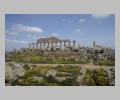| Context: | Selinus |
| Type: | Temple |
| Summary: | Hexastyle peripteral temple on the highest point of the acropolis built during the first half of the 6th century B.C. |
| Date: | ca. 600 BC - ca. 550 BC |
| Dimensions: | The stylobate measures 63.7 x 24. |
| Period: | Archaic |
Plan:
Hexastyle peripteral temple with seventeen columns on the sides. The cella building comprised an adyton, a long and narrow cella, and a pronaos.
Date Description:
The early date of the building is attested by its elongated plan and monolithic columns employed on the south and east sides. The columns also taper from bottom to top.
History:
Erected in the 6th century B.C. and probably dedicated to Apollo, the temple is thought to have fallen during an earthquake in the 5th century A.D., burying a Byzantine settlement, although the city had been sacked in 409 B.C. by the Carthaginians. Fourteen columns of the north colonnade were re-erected beginning in 1925, and the earthquake of 1968 disrupted this reconstruction. Since then, scaffolding has covered it.
Other Notes:
The triglyph frieze carried carved metopes and was surmounted by a cornice revetted with polychrome terracotta slabs. Two gorgoneia, also of painted terracotta, decorated both pediments of the temple. On the temple roof, the ridge pole was covered by the kalypteres also of polychrome terracotta.
The columns are quite large (6 x 17), monolithic, and nearly 2 m in diameter at the base, except for the thicker corner columns.
Sources Used:
Other Bibliography:





